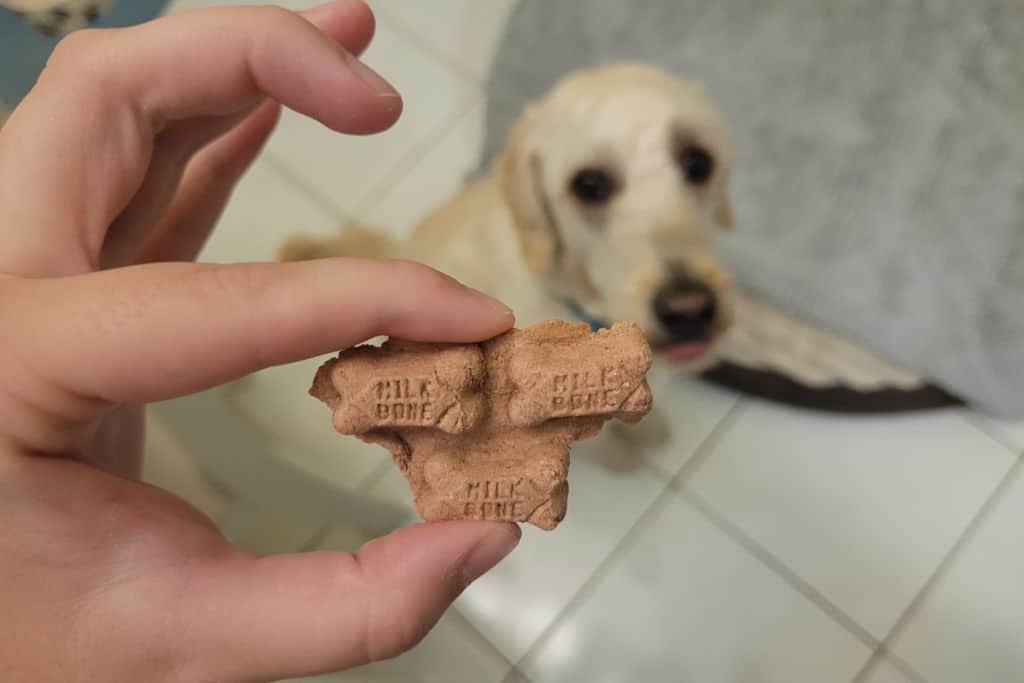What is it that makes milk bones so attractive to dogs? Mine literally skips when he realizes he’s going to get one. They love milk bones more than they love dry food, but why is this?
Dogs would do anything if you give them something that seems like a treat, so your body language, speech style, and conduct have much to do with it. They often react the same if you offer them kibble as a treat. It’s also junk food, tasty but not very good.

Are Milk Bones Genuinely Beneficial to Dogs?
Milk bones are generally safe for your dog to eat. Therefore, occasional junky treats are acceptable, but I would never make them a habit. Milkbones have also been used to soothe reactive dogs, but it doesn’t mean these treats are particularly healthy.
You can use them as a special treat, but if they become a regular treat for your dog, they will lose their potency, and you will be loading your dog up with rubbish. Give your dog dehydrated liver and meat treats instead.
To be safe, set a 10% calorie limit on everything other than nutritionally complete and balanced dog food.
Milk-bones ingredients are usually the same for most manufacturers, but they may differ. Here are the milk bone ingredients from the milkbone.com website:
Ground Whole Wheat, Wheat Flour, Meat and Bone Meal, Milk, Beef Fat (preserved with BHA/BHT), Salt, Natural Flavor, Dicalcium Phosphate, Calcium Carbonate, Malted Barley Flour, Brewers Dried Yeast, Sodium Metabisulfite (used as a preservative), Minerals (Ferrous Sulfate, Zinc Oxide, Manganous Oxide, Copper Sulfate, Calcium Iodate, Sodium Selenite), Vitamins (Vitamin E Supplement, Niacin Supplement, Vitamin A Supplement, D-Calcium Pantothenate, Riboflavin Supplement, Pyridoxine Hydrochloride, Vitamin D3 Supplement, Folic Acid, Biotin, Vitamin B12 Supplement), BHA (used as a preservative).
As you can see, there is a load of ingredients, usually a yellow flag for dog and human food. While some parts are good, others are not so.
The unfavorable ones are around the BHA content, which has been linked to cancer. However, it has been discovered that small amounts are not dangerous, which is why the FDA permits these natural dog treats.
They are not the healthiest or most required, and they don’t provide the dog with any nutritional needs. However, as an occasional treat, they are acceptable.
How Many Milk Bones Can You Give to Your Dog?
A general rule of thumb is that treats aren’t supposed to be more than 10% of the caloric intake for a dog. Anything above that is potentially harmful to them.
Too much of anything is bad for a dog or a person. Milk bone items are intended to be treats rather than staples of the diet. It’s like a candy bar that is not very nutritious but usually harmless in moderation. Millions of dogs eat them every day.
To be safe, you should avoid giving your dog too many milk bones and stick with only a few per day. Not only is it not good for them, but they may not want to eat their main meals when they should.
Our dogs used to get a tummy ache from eating too many and stopped eating them until they felt better. After that, we almost completely stopped giving them milk bones. Sometimes I can’t say no to those puppy-dog eyes.
It’s about ensuring that the total serving amount remains relatively modest but sufficient to encourage a good association.
One of the advantages of Milk Bones is that they are easy to break into small pieces, allowing you to get many uses out of a small amount. But try to avoid giving your dog big milk bones for training. For training, I like to be able to give her tiny treats because she gets them regularly and quickly.
My dogs frequently refuse milk bones because I provide them with freeze-dried raw treats that are meat-based rather than the additives, artificial colors, and flours present in milk bones. I’m overjoyed since those are worthless and useless calories for a dog.
A good alternative is to give your dog dehydrated liver and meat treats instead. Yes, they are more expensive, but they are a much healthier option.
Can Dogs Get Sick From Milk Bones?
They are unlikely to make your dog actively sick unless they have a sensitive stomach. Are milk bones healthy? Let’s say they’re not unhealthy in moderation. It’s like asking if french fries are safe. Sure, but only in moderation, and there are many better options.
It also depends on the manufacturer. Unfortunately, most manufacturers create Milk bones cheaply with cheap components. Higher-quality treats will likely cause fewer problems for your dog unless the substance your dog is allergic to is also present. Finding something that works for your dog may take a lot of trial and error.
Are Milk-Bones Good for Puppies?
Not for a puppy that is a month and a half old. A puppy of this age requires only high-quality puppy chow, either kibble or canned. These diets are designed to meet the dietary requirements of pups, and there should be no human vitamins or treats.
Related: Essential Vitamins for Dogs
Young puppies of one to two months should not be fed or given any form of treat, but if you must, keep them minimal. They should be fed by the mother or, if that is not possible, moist high-quality puppy chow/kibble, possibly mixed with oatmeal. Ask your vet for more information.
Some larger breed puppies require a limited quantity of calcium in their meals. Extra calcium during growth can actually be detrimental rather than beneficial, so you should consult your veterinarian.
FAQs
Can humans eat milk bones?
Milk bones can be consumed by humans and are generally safe. They usually taste like dry, unflavored biscuits. They’re not very good; try one and compare it to a bland crispy cookie. They can be hard and are not meant for the human digestive system.
What are some excellent home dog treats?
There is no need to buy garbage from the shop when your kitchen is stocked with healthy dog treats. For portable snacks, create meat jerky in the oven, and some dogs even prefer veggies, which are lovely low-calorie alternatives. You can give little bits of fresh liver, scrambled egg, or a taste of cheese as at-home treats.
What food is generally poisonous to dogs?
BHA is a popular preservative used in dog food, and research suggests it may cause cancer. Furthermore, avoid animal byproducts, corn as the central ingredient in dog food, raw diet if not adequately prepared, and xylitol, which is poisonous to dogs.
Alex, a passionate animal lover, has experience in training and understanding animal behavior. As a proud pet parent to two dogs and three cats, he founded AnimalReport.net to share insights from animal experts and expand his knowledge of the animal kingdom.




